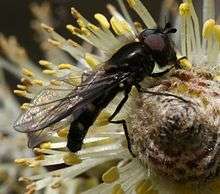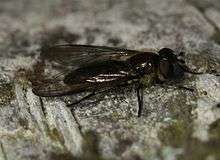Melangyna quadrimaculata
Melangyna quadrimaculata is a European species of hoverfly.[1][2]
| Melangyna quadrimaculata | |
|---|---|
 | |
| male | |
 | |
| female | |
| Scientific classification | |
| Kingdom: | |
| Phylum: | |
| Class: | |
| Order: | |
| Family: | |
| Genus: | |
| Species: | M. quadrimaculata |
| Binomial name | |
| Melangyna quadrimaculata (Verrall, 1873) | |
| Synonyms | |
|
| |
Description
External images
For terms see Morphology of Diptera
Wing length 7·25–9 mm. Males only four spots on the abdomen. Female tergites black, pale abdominal markings absent. Eyes with short hairs. The male terminalia are figured by Hippa (1968) ).[3] Larva described and figured by Rotheray (1994).[4] See references for determination.[5]
[6]
[7][8]
Distribution
Palearctic Southern Norway, Sweden, Finland and Denmark South to Belgium. Ireland East through Central Europe into European Russia and on to the Russian Far East, Siberia and the Pacific coast (Sakhalin). [9][10]
Biology
Habitat Fagus and Quercus ancient woodlands, also in extensive parks in with overmature trees.[11] Arboreal, but descends to visit flowers of Alnus, Anemone nemorosa, Carpinus, Chrysosplenium oppositifolium, Corylus, Hamamelis mollis, Lonicera xylosteum, Populus tremula, Salix, Sambucus, Tussilago.[12] The flight period is end February to end April. The larvae are predacious on adelgids on firs.
References
- Stubbs, Alan E.; Falk, Steven J. (1983). British Hoverflies: An Illustrated Identification Guide (2nd ed.). London: British Entomological and Natural History Society. pp. 253, xvpp. ISBN 1-899935-03-7.
- Ball, S.G.; Morris, R.K.A. (2000). Provisional atlas of British hoverflies (Diptera, Syrphidae). Monks Wood, UK: Biological Record Centre. pp. 167 pages. ISBN 1-870393-54-6.
- Hippa, H. (1968) A generic revision of the genus Syrphus and allied genera (Diptera: Syrphidae) in the Palearctic region, with descriptions of the male genitalia. Acta Ent.Fenn., 25: 1-94.
- Rotheray G., 1993 Colour Guide to Hoverfly Larvae Diptera, Syrphidae in Britain and Europe Dipterists Forum pdf
- Van Veen, M. (2004) Hoverflies of Northwest Europe: identification keys to the Syrphidae. 256pp. KNNV Publishing, Utrecht.addendum
- Van der Goot,V.S. (1981) De zweefvliegen van Noordwest - Europa en Europees Rusland, in het bijzonder van de Benelux. KNNV, Uitgave no.32: 275pp. Amsterdam.
- Bei-Bienko, G.Y. & Steyskal, G.C. (1988) Keys to the Insects of the European Part of the USSR, Volume V: Diptera and Siphonaptera, Part I. Amerind Publishing Co., New Delhi. ISBN 81-205-0080-6.
- Coe, R.L. (1953) Diptera: Syrphidae. Handbks.ident.Br.insects, 10(1): 1-98. R.ent.Soc.London. pdf
- Fauna Europaea
- Peck, L.V. (1988) Syrphidae. In: Soos, A. & Papp, L. (eds.) Catalogue of Palaearctic Diptera, 8: 11-230. Akad.Kiado, Budapest.
- Speight, M.C.D. (2011). "Species accounts of European Syrphidae (Diptera)" (PDF). Syrph the Net, the database of European Syrphidae. 65: 285pp.
- de Buck, N. (1990) Bloembezoek en bestuivingsecologie van Zweefvliegen (Diptera, Syrphidae) in het bijzonder voor België. Doc.Trav. IRSNB, no.60, 1-167.